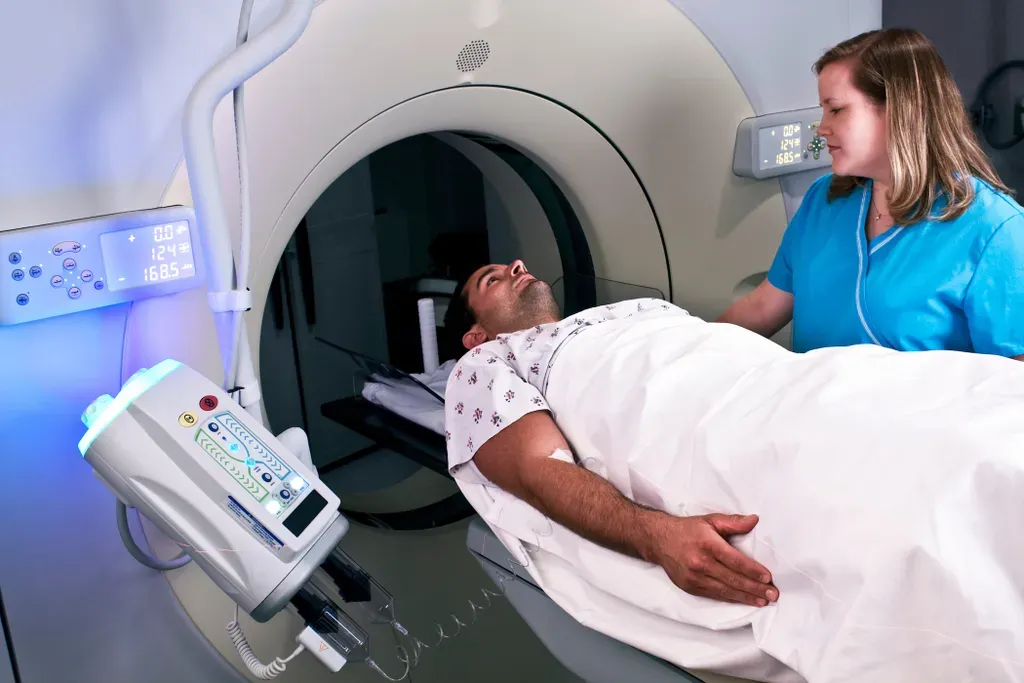
About CAT Scan
Definition
A computed tomography (CT) scan is an imaging method that uses x-rays to create pictures of cross-sections of the body.
Related tests include:
- Abdominal and pelvis CT scan
- Cranial or head CT scan
- Cervical, thoracic, and lumbosacral spine CT scan
- Orbit CT scan
- Chest CT scan
How the Test is Performed
You will be asked to lie on a narrow table that slides into the center of the CT scanner.
Once you are inside the scanner, the machine's x-ray beam rotates around you. Modern spiral scanners can perform the exam without stopping.
A computer creates separate images of the body area, called slices. These images can be stored, viewed on a monitor, or printed on film. Three-dimensional models of the body area can be created by stacking the slices together.
You must stay still during the exam, because movement causes blurred images. You may be told to hold your breath for short periods of time.
Complete scans most often take only a few minutes. The newest scanners can image your entire body in less than 30 seconds.
How to Prepare for the Test
Certain exams require a special dye, called contrast, to be delivered into your body before the test starts. Contrast helps certain areas show up better on the x-rays.
Let your health care provider know if you have ever had a reaction to contrast. You may need to take medicines before the test in order to avoid another reaction.
Contrast can be given several ways, depending on the type of CT being performed.
It may be delivered through a vein (IV) in your hand or forearm.
- You might drink the contrast before your scan. When you drink, the contrast depends on the type of exam being done. The contrast liquid may taste chalky, although some are flavored. The contrast passes out of your body through your stools.
- Rarely, the contrast may be given into your rectum using an enema.
If contrast is used, you may also be asked not to eat or drink anything for 4 to 6 hours before the test.
Before receiving IV contrast, tell your health care provider if you take the diabetes medication metformin (Glucophage). People taking this medicine may need to stop temporarily. Also, let your provider know if you have any problems with your kidneys. The IV contrast can worsen kidney function.
Find out if the CT machine has a weight limit if you weigh more than 300 pounds (135 kilograms). Too much weight can damage the scanner.
You will need to remove jewelry and wear a hospital gown during the study.
How the Test Will Feel
Some people may have discomfort from lying on the hard table.
Contrast given through an IV may cause a slight burning feeling, a metallic taste in the mouth, and a warm flushing of the body. These sensations are normal and usually go away within a few seconds.
Why the Test is Performed
A CT scan creates detailed pictures of the body, including the brain, chest, spine, and abdomen. The test may be used to:
- Diagnose an infection
- Guide a surgeon to the right area during a biopsy
- Identify masses and tumors, including Cancer
- Study blood vessels
Normal Results
Results are considered normal if the organs and structures being examined are normal in appearance.
What Abnormal Results Mean
Abnormal results depend on the part of the body being studied. Talk to your provider about questions and concerns.
Risks
Risks of CT scans include:
- Allergic reaction to the contrast dye
- Damage to kidney function from the contrast dye
- Exposure to radiation
CT scans expose you to more radiation than regular x-rays. Having many x-rays or CT scans over time may increase your risk for cancer. However, the risk from any one scan is small. You and your doctor should weigh this risk against the value of the information that will come from a CT scan. Most new CT scan machines have the ability to reduce the radiation dose.
Some people have allergies to contrast dye. Let your provider know if you have ever had an allergic reaction to injected contrast dye.
The most common type of contrast given into a vein contains iodine. If you have an iodine allergy, a type of contrast may cause nausea or vomiting, sneezing, itching, or hives.
If you absolutely must be given such contrast, your doctor may give you antihistamines (such as Benadryl) or steroids before the test.
Your kidneys help remove iodine from the body. You may need to receive extra fluids after the test to help flush iodine out of your body if you have diabetes or kidney disease.
Rarely, the dye may cause a life-threatening allergic response called anaphylaxis. If you have any trouble breathing during the test, tell the scanner operator immediately. Scanners come with an intercom and speakers, so the operator can hear you at all times.
Alternative Names
CAT scan; Computed axial tomography scan; Computed tomography scan